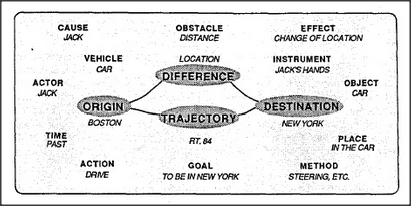


Our first Trans-frame scheme was connected to only four pronomes — Origin, Destination, Difference, and Trajectory. These are just enough to link together a simple chain of reasoning. But what about all the other roles that things can play — like Actors, Recipients, Vehicles, Goals, Obstacles, and Instruments? In order to keep track of these, we surely need some other pronomes, too. So now we shall imagine a larger kind of Trans-frame scheme that engages, all at once, a much larger constellation of different pronome roles.

Why propose this particular structure instead of some other arrangement? Because I suspect that Trans-like structures have a special prominence in how we think. One reason is that some sort of bridgelike scheme seems indispensable for making those all- important connections between structures and functions. Without that bridge trajectory, it might be hard to connect what we learn about things to what we learn about using them. Also, in order to use chainlike thinking skills, we need to be able to represent what we know in ways that provide connection points for roles like Origins, Destinations, and Differences. All these requirements suggest the use of bridgelike frames.
One might wonder if we need to use any standard representations at all. The answer is that we do, indeed, if only because of the Investment principle. No matter what kind of representations we adopt, there's nothing we could do with them until we also learn effective skills and memory-scripts that work with them. And since such complex skills take time to grow, we'd never have enough time to learn new sets of representations for every different new idea. No powerful skills would ever emerge without some reasonably uniform schemes for representing knowledge.
Trans-like representation-schemes have been very useful in Artificial Intelligence research projects. They have been useful, among other things, for making theories of problem solving, for making clever computer programs to simulate expertise in various specialties, and for making programs that understand languagelike expressions to limited degrees. In the next few sections we'll see how to use them for making several different kinds of chains of reasoning.